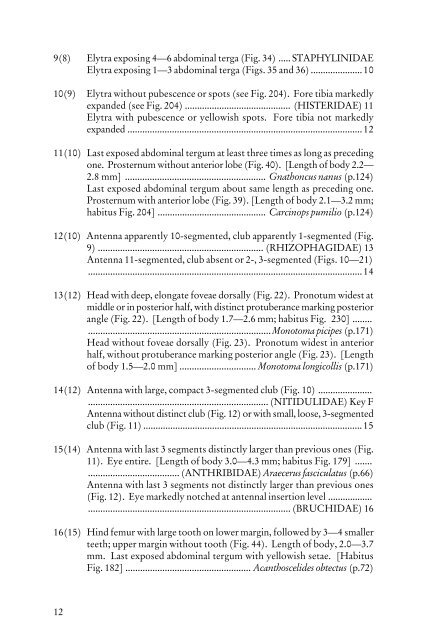Beetles Identification Guide
Beetles Identification Guide
Beetles Identification Guide
Create successful ePaper yourself
Turn your PDF publications into a flip-book with our unique Google optimized e-Paper software.
9(8) Elytra exposing 4—6 abdominal terga (Fig. 34) ..... STAPHYLINIDAE<br />
Elytra exposing 1—3 abdominal terga (Figs. 35 and 36) .....................10<br />
10(9) Elytra without pubescence or spots (see Fig. 204). Fore tibia markedly<br />
expanded (see Fig. 204) ........................................... (HISTERIDAE) 11<br />
Elytra with pubescence or yellowish spots. Fore tibia not markedly<br />
expanded ...............................................................................................12<br />
11(10) Last exposed abdominal tergum at least three times as long as preceding<br />
one. Prosternum without anterior lobe (Fig. 40). [Length of body 2.2—<br />
2.8 mm] ......................................................... Gnathoncus nanus (p.124)<br />
Last exposed abdominal tergum about same length as preceding one.<br />
Prosternum with anterior lobe (Fig. 39). [Length of body 2.1—3.2 mm;<br />
habitus Fig. 204] ............................................ Carcinops pumilio (p.124)<br />
12(10) Antenna apparently 10-segmented, club apparently 1-segmented (Fig.<br />
9) ................................................................... (RHIZOPHAGIDAE) 13<br />
Antenna 11-segmented, club absent or 2-, 3-segmented (Figs. 10—21)<br />
...............................................................................................................14<br />
13(12) Head with deep, elongate foveae dorsally (Fig. 22). Pronotum widest at<br />
middle or in posterior half, with distinct protuberance marking posterior<br />
angle (Fig. 22). [Length of body 1.7—2.6 mm; habitus Fig. 230] ........<br />
..........................................................................Monotoma picipes (p.171)<br />
Head without foveae dorsally (Fig. 23). Pronotum widest in anterior<br />
half, without protuberance marking posterior angle (Fig. 23). [Length<br />
of body 1.5—2.0 mm] ............................... Monotoma longicollis (p.171)<br />
14(12) Antenna with large, compact 3-segmented club (Fig. 10) ......................<br />
......................................................................... (NITIDULIDAE) Key F<br />
Antenna without distinct club (Fig. 12) or with small, loose, 3-segmented<br />
club (Fig. 11) .........................................................................................15<br />
15(14) Antenna with last 3 segments distinctly larger than previous ones (Fig.<br />
11). Eye entire. [Length of body 3.0—4.3 mm; habitus Fig. 179] .......<br />
..................................... (ANTHRIBIDAE) Araecerus fasciculatus (p.66)<br />
Antenna with last 3 segments not distinctly larger than previous ones<br />
(Fig. 12). Eye markedly notched at antennal insertion level ..................<br />
.................................................................................. (BRUCHIDAE) 16<br />
16(15) Hind femur with large tooth on lower margin, followed by 3—4 smaller<br />
teeth; upper margin without tooth (Fig. 44). Length of body, 2.0—3.7<br />
mm. Last exposed abdominal tergum with yellowish setae. [Habitus<br />
Fig. 182] ................................................... Acanthoscelides obtectus (p.72)<br />
12
















